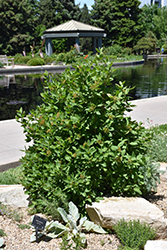Mini Man™ Dwarf Manchurian Viburnum Viburnum burejaeticum 'P017S' Height: 6 feet Spread: 6 feet
Sunlight:
Hardiness Zone: 3a Brand: Plant Select Description: A charming dwarf shrub with multi-season interest; creamy white flower clusters in spring followed by berries that fade from red to glossy black and persist into winter, rich red-purple fall color; useful in mixed borders or foundation plantings Ornamental Features Mini Man™ Dwarf Manchurian Viburnum is clothed in stunning white flat-top flowers at the ends of the branches in mid spring. The red fruits which fade to black over time are held in abundance in spectacular clusters from mid summer to early winter. It has dark green deciduous foliage which emerges light green in spring. The oval leaves turn an outstanding red in the fall. Landscape Attributes Mini Man™ Dwarf Manchurian Viburnum is a multi-stemmed deciduous shrub with a more or less rounded form. Its average texture blends into the landscape, but can be balanced by one or two finer or coarser trees or shrubs for an effective composition. This is a relatively low maintenance shrub, and should only be pruned after flowering to avoid removing any of the current season's flowers. It is a good choice for attracting birds to your yard, but is not particularly attractive to deer who tend to leave it alone in favor of tastier treats. It has no significant negative characteristics. Mini Man™ Dwarf Manchurian Viburnum is recommended for the following landscape applications;
Planting & Growing Mini Man™ Dwarf Manchurian Viburnum will grow to be about 6 feet tall at maturity, with a spread of 6 feet. It has a low canopy, and is suitable for planting under power lines. It grows at a medium rate, and under ideal conditions can be expected to live for 40 years or more. While it is considered to be somewhat self-pollinating, it tends to set heavier quantities of fruit with a different variety of the same species growing nearby. This shrub does best in full sun to partial shade. It is very adaptable to both dry and moist growing conditions, but will not tolerate any standing water. It is considered to be drought-tolerant, and thus makes an ideal choice for xeriscaping or the moisture-conserving landscape. This plant will benefit from an application of bonemeal and/or mycorrhizal fertilizer at the time of planting. It is not particular as to soil type or pH. It is highly tolerant of urban pollution and will even thrive in inner city environments. Consider applying a thick mulch around the root zone in winter to protect it in exposed locations or colder microclimates. This is a selected variety of a species not originally from North America. Characteristics
Applications
Features & Attributes
|
